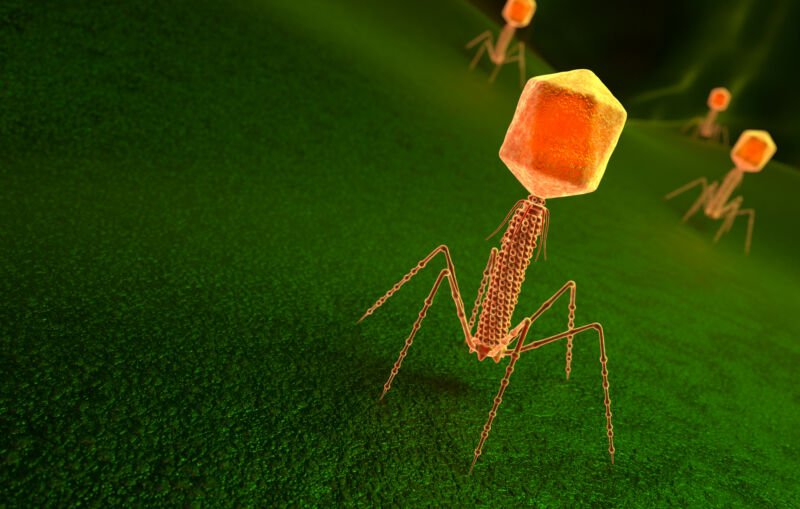
Long before people were interested in killing bacteria, viruses were at work. Viruses that attack bacteria, called “phages” (short for bacteriophage), were first identified by their ability to create bare patches on the surface of culture plates that were otherwise covered by a lawn of bacteria. Having played critical roles in the early development of molecular biology, a number of phages have been developed as potential therapies for use when antibiotic resistance limits the effectiveness of traditional drugs.
But we are relatively late in turning phages into tools. Researchers have described a number of cases where bacteria have retained parts of disabled viruses in their genomes and turned them into weapons that can be used to kill other bacteria that might otherwise compete for resources. I just became aware of that weaponry, thanks to a new study showing that this process has helped maintain diverse bacterial populations for centuries.
The development of a killer
The new work began when researchers were studying the population of bacteria associated with a plant growing wild in Germany. The population included various members of the genus Pseudomonas, which may include plant pathogens. Normally, when bacteria infect a new victim, a single strain expands dramatically after successfully exploiting its host. In this case, however, Pseudomonas the population contained a number of different species that appeared to maintain stable competition.
To learn more, the researchers obtained over 1,500 individual genomes from the bacterial population. Over 99 percent of these genomes contained bits of virus, with the average bacterial strain having two separate bits of virus hidden in their genome. All of these had missing parts compared to a functioning virus, suggesting that they were the product of a virus that had been introduced in the past but had since received damage that disabled them.
In itself, this is not shocking. Many genomes (including our own) have many disabled viruses in them. But bacteria tend to eliminate foreign DNA from their genomes quite quickly. In this case, a particular viral sequence appeared to date from the common ancestor of many of the strains since they all had inserted the virus into the same place in the genome and all instances of that particular virus had been inactivated by losing the the same set of genes. The researchers named this sequence VC2.
Many phages have a stereotypical structure: a large “head” containing their genetic material, perched atop a stalk that ends in a set of “legs” that help attach to their bacterial victims. Once the legs make contact, a stalk contracts, an action that helps transfer the virus genome into the bacterial cell. In the case of VC2, all of its copies lacked the genes for the production of the head section, as well as all the genes needed to process its genome during infection.
This led researchers to suspect that VC2 was something called “tailocin.” These are former phages that have been domesticated by bacteria so that they can be used to harm potential bacterial competition. Bacteria with a tailocin can produce partial phages consisting only of legs and stalks. These tylocins can still find and bind to other bacteria, but when the stem shrinks, there is no genome to inject. Instead, it simply punches a hole in their victim’s membrane, partially eliminating the cell’s boundary and allowing some of its contents to leak out, leading to its death.
An evolutionary free for all
To confirm that the VC2 sequence encodes a thylocin, the researchers grew several bacteria that contained the sequence, purified proteins from it, and used electron microscopy to confirm that they contained headless phages. By exposing other bacteria to tylocin, they found that while the strain that produced it was immune, many other strains growing in the same environment were killed by it. When the team deleted the genes that encode key parts of the tail, the killing went away.
The researchers hypothesize that the system is used to eliminate potential competition, but that many strains have evolved resistance to tailocin.
When the researchers did a genetic screen to identify resistant mutants, they found that the resistance was provided by mutations that interfered with the production of complex sugar molecules found in proteins that end up on the outside of cells. At the same time, most of the genetic variation between the VC2 genes occurs in the proteins that encode the legs, which bind to these sugars.
So it seems that each type of bacteria is both aggressor and victim, and there is an evolutionary arms race that leads to a complex collection of pairwise interactions between species – think of a game of rock/paper/scissors with dozens of options. And the arms race has a history. Using older samples, the researchers show that many of the variations in these genes have existed for at least 200 years.
Evolutionary races are often seen as a simple one-on-one fight, perhaps because that’s an easy way to think about them. But the reality is that most are more akin to a chaotic barroom brawl—an occasion where it’s rare for either faction to gain a permanent advantage.
Science, 2024. DOI: 10.1126/science.ado0713 (About DOIs).